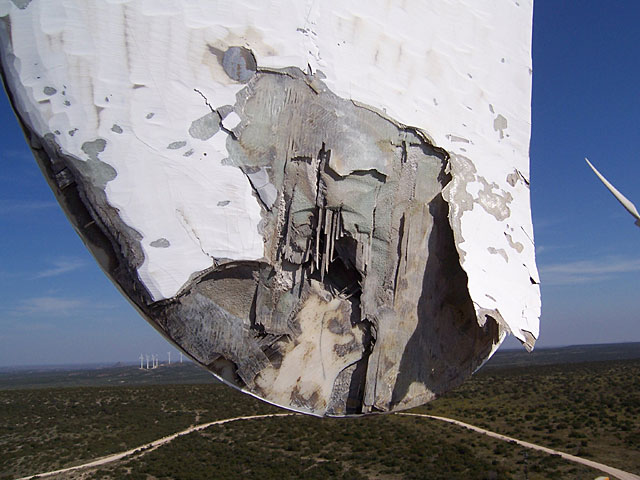7/2/09 If a wind turbine blade explodes in a German forest and no one in the USA hears about it, does it make a sound?
July 2, 2009: Wind Turbine throws blades, cuts path through forest

A fierce storm on the afternoon of July 2, 2009 destroyed portions of an industrial wind turbine located between Brieske and Schwarzheide in Germany.
Pieces, as shown in this photo, flew 150 meters (about 500 feet) through the air landing about 50 meters (about 170 feet) from federal highway Nr. 169.
No one was injured.
The approximately 40 meter (about 100 feet) blade broke several trees as it cut a track through the forest. The blade showed signs of lightning damage.

Extra Credit Question:
WHAT HAPPENS WHEN LIGHTING HITS A TURBINE BLADE?
When Lightning Strikes Wind Turbines
[Click here to read at source]
By Kate Galbraith

With snow, ice and frigid weather, winter creates complications for renewable energy, as I wrote last week. But for Ralph Brokaw, a Wyoming rancher with both cows and wind turbines on his land, the worst hazard is not the ice that his blades can throw off in the winter.
Rather, it is lightning strikes on the towers, which usually occur in summer when there are more storms.
The effect is spectacular — and scary. “It will explode those blades, and they’ll throw chunks of blade several hundred feet,” Mr. Brokaw, a member of his local fire department, told me over the telephone.
As the chunks fall, the firefighters douse them with water. Otherwise, “There’s really not much you can do with a turbine that’s 200 foot tall and on fire,” he said.
Mr. Brokaw said that in the past five years he has been called to help put out two or three turbine fires. He said that “there’s oil and gearboxes and a tremendous amount of wiring” in the generator — so even though the turbines are very well-grounded, they can sometimes light up.
MORE EXTRA CREDIT READING: [Source]
When Lightning Strikes Wind Turbines II
Back in December, a Wyoming rancher described to me the terrifying fireworks that ensue when a bolt of lightning hits a wind turbine.
“It will explode those blades, and they’ll throw chunks of blade several hundred feet,” said Ralph Brokaw, whose ranch accommodates both turbines and cows.
After I wrote the post, I got an e-mail message from Kim Loehr of the Lightning Protection Institute. She wrote to tell me that the National Fire Protection Association has updated its handbook on installing lightning protection systems to include a new section on wind machines.
Due to the proliferation of wind farms and the increasing heights of the turbines — some of them more than 250 feet tall — there is, she noted, a rising number of lightning-related incidents.
Now that the thunderstorm season is rolling around (central Texans were roiled by lightning shows over the weekend), I thought I would share a few pointers.
According to the handbook, wind turbines are particularly complicated to protect because they have so many different components — including non-conducting composite materials like glass-reinforced plastic. Any lightning protection system must therefore be sufficiently comprehensive to take account for all of the parts.
“While physical blade damage is the most expensive and disruptive damage caused by lightning,” the handbook states, “by far the most common is damage to the control system.”
The massive blades will often have a receptor at the tip, which can channel the lightning into the proper wires and onward to the ground. Two receptors might be necessary for larger blades.
“Protecting wind turbine blades against lightning is not about avoiding strikes, but attracting them,” states LM Glasfiber, a global blade manufacturer, on a section of its Web site devoted to lightning. “This makes it possible to direct the flow of the lightning and ensure that the components exposed to its effects can withstand the forces involved.”
The company says that it meets certification standards requiring blades to be capable of withstanding 98 percent of lightning strikes.
Without the system, though, it’s not pretty: “A lightning strike on an unprotected blade can lead to temperature increases of up to 30,000 degrees Celsius, and result in an explosive expansion of the air within the blade,” LM Glasfiber states.
EVEN MORE EXTRA CREDIT READING:
Case study of lightning damage to wind turbine blade
May, 2008 by Richard Kithil
This brief document provides a case study ofa wind energy facility in Texas and the effect of lightning strikes on wind turbine blades.
Despite the1.5 MW turbine blades having been equipped with lightning protection, the blades failed as a result of lightning strikes.
According to the report:
Lightning protection consists of several exterior copper “receptor” air termination discs, which are fastened to interior aluminum conductors running the length of the blade.
Conductors are fastened to the blade and to one another with steel bolts.
Near the blade root a portion of the conductor is imbedded into the fibreglas.
The conductor transitions from the blade root area via bonding to the hub and thence to a ground reference.
Other components of the lightning protection systems were examined briefly.
The manufacturer provided satisfactory surge protection for sensitive electronics.
Grounding requirements were completed “per manufacturer’s specifications” by the installation contractor.
Conclusion:
The lightning conductor did not conduct as designed.
Lightning created an internal shock wave from air or moisture expansion, or both.
Lightning temperatures may have caused interior moisture to transition to an expansive state (steam).
In turn, over-pressures stressed the blade to subsequent failure.
Further research into wind turbine blade interior air/moisture expansion issues is needed.
The full report can be accessed by clicking on the .pdf link below.
Web link: http://www.lightningsafety.com/nlsi_lhm/wind1.html
Download File(s):
wind_blade_damage.pdf (426.6 kB)
 Wind turbine blade tip damaged by lighting
Wind turbine blade tip damaged by lighting